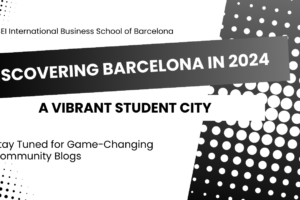
ESEI’s Project-Based Learning: Strategic Marketing
- Categories ESEI Core Values, Barcelona, ESEI Community

Strategic Marketing Project:
Markstrat is a marketing simulation software that offers a risk-free platform to test strategic theories and make decisions.
In our course Strategic Marketing, the class was separated into teams competing with each other with each team managing a brand including its products. The software Markstrat in itself is great. It’s giving an overview of all the processes that must be followed by companies to effectively manufacture and sell their products. In theory, students learn what it truly means to manage a company.
Learning outcomes and how this type of ‘exercise’ shapes students
Marketing is a crucial aspect of any business, and understanding how to make effective marketing decisions is essential for success. In this blog post, we’ll explore how ESEI Students acquired the knowledge and skills necessary to make strategic decisions that will benefit their personal and professional growth.
What knowledge and skills will you acquire after completing the course?
The product life cycle is a model that describes the stages a product goes through from introduction to decline. By learning about this process, our students gained insight into the market dynamics that affect product success. They used this knowledge to make strategic decisions about product development, pricing, and promotion in this project.
How will the course material contribute to your personal and professional development?
Professionally, it contributes to helping our students to improve their team-building skills.
Student Feeback:
“I was the natural team leader of my group. It was not easy at all to take decisions because we had different points of view.” – ESEI Student
“Personally, I have learned that failures are part of the learning process of any professional. We were the least efficient at the beginning but by trying again and again, we reach the 2nd position over five groups.” – ESEI Student
What are the specific areas of the subject that the course will cover?
- The marketing mix, also known as the 4 Ps (product, price, promotion, and place), is a framework for developing and implementing marketing strategies. By understanding the interplay between these elements, you can create a cohesive marketing plan that addresses customer needs and differentiates your product from competitors.
- Distribution channels are the pathways through which products reach consumers. Learning about the different types of distribution channels and their advantages and disadvantages can help you make informed decisions about how to get your product to market.
- Pricing is a critical component of marketing strategy, as it affects both revenue and customer perception. A marketing course can teach you about the different pricing strategies available, such as cost-plus pricing, penetration pricing, and skimming pricing, and help you choose the best one for your product and market.
- Many marketing courses use simulators that allow you to test your decision-making skills in a realistic business environment. By using a marketing simulator, you can practice making strategic decisions based on market data and see the outcomes of those decisions.

Strategic Marketing Project Feedback from Students
How did you start with this project?
We start by analyzing the data from the dashboard of the enterprise, to understand what products they have and the financial situation of the enterprise. Later we had a look at the market forecast to see the market tendance
You had 10 decisions to make, what were these 10 decisions based upon?
All of the 10 decisions were about:
- Improving our price strategy
- Create a new product with the standard required by the customers according to the semantic scales.
- Focus on a market segmentation
- Prioritize a market channel for distribution.
What challenges you faced at the beginning and how did you overcome them?
We faced different challenges. First of all, we faced a leadership problem. Each of us had a point of view about the market. Additionally, we did not really understand the trend of the market. We did not know what to look for in order to understand what is happening really in the market. I struggled a lot.
Finally, to overcome it, we had to establish a team leader. And then, we bought the market forecast from the simulator to understand the trend of the market and finally implement a consistent marketing strategy.
What was the chronology of your experience working with Markstrat?
- In the beginning, the tool was very confusing because we could not find the sections for different information that we were looking for. So we start struggling.
- After two or three periods, we start understanding the market trends and understand specifically where the information that we need is.
- From that moment, we start understanding the market and we change our strategy by improving our pricing strategy and product.
- And finally, we keep investing in our product awareness through marketing in order to increase sales.
9 Benefits of using Business Simulations in your programs
- Enhanced teamwork
- Boosts competitive thinking
- Encouraging analytical thinking
- Practiced decision-making
- On-the-job experience
- Engages emotions
- Increased retention
- Better employability
- Trusted globally
What tool did our students use?
Markstrat is a marketing simulation software that offers students and professionals a risk-free platform to test strategic theories and make decisions.
Our number one marketing simulation will turn participants into effective strategic marketers. With 2-5 days of running time, Markstrat provides the complete strategic marketing experience for your educational programs.
Special thanks to our ESEI Student:
Samuel Zetrenne is a part of the International MBA Student body at ESEI. The feedback given for this blog came from him which has allowed us to help write this blog for future students to understand how ESEI Project-Based Learning is.
Looking For Cultural Activities in Barcelona?
Previous post
Celebrating International Environmental Education Day: Promoting Sustainable Development
Next post



